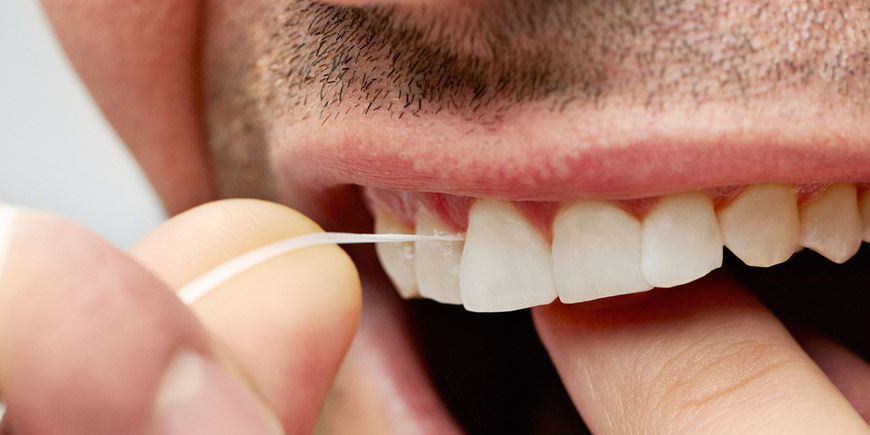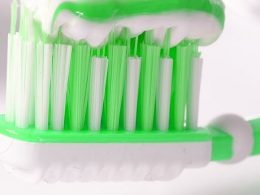Table of Contents
Dental floss and other interdental resources such as interproximal brushes, plastic toothpicks, rubber tips and oral irrigators; remove food debris and dental plaque that get trapped between teeth, before they cause dangerous cavities or calcify and form tartar or dental calculus. Toothbrush bristles, by themselves, are not efficient at cleaning between teeth.
Plaque that is not removed can harden into tartar, a solid mineral deposit that forms on teeth that can only be removed by a professional dental cleaning. When this happens, brushing and cleaning between the teeth becomes nearly impossible and the gum tissue becomes inflamed, it gets red, and begins to bleed. This condition is known as gingivitis, the initial stage of periodontal disease.
Interdental cleaning techniques add significant benefits in reducing plaque rates when used in conjunction with conventional toothbrushes. The choice of technique to use should be made according to the characteristics of each patient, for example, dental floss for individuals with closed interdental spaces and interproximal brushes for patients with periodontitis or more open interdental spaces.
Interdental cleaning helps remove debris and interproximal dental plaque, that which accumulates between the surfaces of two teeth in contact. Flossing and other interdental resources help clean these hard-to-reach surfaces and reduce the likelihood of tooth decay and gum disease, which is why we consider them an essential part of caring for teeth, dental implants, and gums.
Dental Floss
Flossing was once made from silk fibers twisted to form a long strand, but today it is usually made from nylon filaments or plastic monofilaments. Dental floss can be treated with flavoring agents such as mint, to make it more pleasant to use, and with wax; so that it glides more easily.
We truly believe that there is no major difference in the effectiveness of waxed or unwaxed dental floss, although it is important to know that some cases of wax hypersensitivity have been reported. Usually, it is not about the type of floss that is chosen, but how and when it is used.
Flossing Instructions
1- Break off about 18 to 24 inches of dental floss. To hold it properly, wrap most of it around both index fingers. Leave only about 1 to 2 inches between both hands.
2- Next, tighten the dental floss, separating your hands a little and take control with the tips of your thumbs.
3- Place it between two teeth and apply light pressure to overcome the resistance of the contact point. Gently slide the dental floss up and down, rubbing first against the surface of one tooth, then against the other. Do not slide the floss into the soft tissue as it may injure it.
4- When level gums, double floss and embrace the tooth to form a C. This allows the dental floss to adapt better to the area and cover a greater surface of it.
5- Repeat the steps as you move from tooth to tooth. If the floss tears or breaks, you will need to cut a new piece.
There are some products and devices specially designed to facilitate the use of this resource such as floss holders, floss threaders and floss picks.
Floss Holders
A holder is a device that holds the dental floss, thus eliminating the need to maneuver so much with the fingers.
There are a great variety of them. The most common consist of a Y-shaped device with a separation of ¾ to 1 inch between its tips. The floss is placed between them and held securely, using the handle to guide manual movements.
It is very useful for those who have difficulty moving their hands or fingers, for people with disabilities, very big hands, limited mouth opening, a lot of nausea and/or little motivation to flossing due to the cumbersome process. It is also very useful when someone else is helping the patient with the technique.
Numerous studies have shown that the effectiveness of floss holders for the removal of dental plaque is very similar to that of the conventional or digital technique.
Threaders
A floss threader is a kind of plastic loop into which a piece of floss is inserted and tied, very similar to a needle threader. Dental threaders are simple, disposable tools that are sold in the oral care section of almost any store or pharmacy. They are easy to use with any type of dental floss.
They are very useful for people with fixed bridges and orthodontic appliances, since they allow cleaning between the brackets and the pontics or phantoms of the bridges. Next, we briefly describe its use:
1- Take a piece of between 12 and 15 inches of your favorite dental floss.
2- Insert approximately 4 inches from one end of the floss into the loop of the threader.
3- Pass the threader under or over any dental appliance, such as braces, fixed retainers, and fixed bridges.
4- Detach the threader from the dental floss and gently slide the floss back and forth, up and down; between the teeth and the edge of the gums.
5- Repeat the procedure by zones.
Floss Picks
A floss pick is a small plastic tool with a curved end that holds a piece of dental floss. At the other end, it has a small plastic tip that can be used in place of a wooden toothpick to remove large food particles that get caught between your teeth.
Some of these toothpicks are fully disposable and others have reusable heads. They also exist with non-slip handles to make them even easier to hold. Others have an area that works like a tongue scraper, and others are very small; specially designed for children.
Interdental Aids
Interdental auxiliaries are used as a complement to normal brushing to clean between tooth contact surfaces, those areas between tooth and tooth that the conventional brush cannot reach. They help people remove interproximal plaque.
To determine which auxiliary is the most appropriate for you, the following criteria should be used: your periodontal condition (including the anatomical challenges of exposed root surfaces and the type of interdental embrasures), presence and type of dental prosthesis (if applicable), age, motivation and manual dexterity; among others.
All interdental cleaning techniques should be performed once or twice a day, with an emphasis at night. Many authors recommend practicing them before normal brushing, and not after.
When plaque is removed from proximal surfaces first, the fluoride in toothpaste can reach the proximal surfaces more easily, helping to prevent tooth decay. In addition, people tend to be more meticulous about whatever tasks they do at the beginning, allowing them to focus their attention on the most difficult to reach areas. Lastly, after brushing, they may not feel as motivated to perform interdental cleaning, simply because their mouth already feels clean and fresh.
We will now see the different types of auxiliaries and how they are used.
Interdental Brushes
Interdental brushes are also known as interproximal brushes and are manufactured in different sizes and designs. The brush consists of a plastic handle and a small tapered or cylindrical filamentary brush tip that is attached to the handle (not replaceable) or inserted into it (replaceable).
Some designs have a straight handle and others are angled. Angled handle provides better access to posterior areas. A recent study showed that interproximal brushes, regardless of their shape, remove plaque better than dental floss from the spaces between the teeth. Another study found that the use of the interproximal brush resulted in better periodontal health, even without treatment of any kind in already ill patients.
These brushes are recommended for interproximal areas or areas between the teeth where the gingiva is absent or shortened, or where there are root concavities. This brush can also be used to clean around orthodontic appliances, fixed retainers, small gaps or gaps between teeth, fixed prostheses, splints and dental implants; when the spaces are large enough to easily receive the instrument.
For use it, the tip of the brush must be moistened and inserted at an angle, following the contour of the gum. Then, it should be moved from the side of the tooth that faces the cheek to the opposite side that faces the tongue, to remove debris trapped between the teeth.
These brushes come in different sizes to make it possible to use them in niches of different dimensions. The tip of the brush should be slightly bigger than the space to be addressed and cleaned.
Studies have shown the effectiveness of interdental brushes in removing plaque and reducing gingival bleeding. In open or very large embrasures, these brushes are superior to any other interdental device, including dental floss, because their bristles fill the space completely and reach the root surfaces and concavities.
Plastic Toothpicks
A modern adaptation of the traditional wooden toothpick is the triangular shaped plastic toothpick. Interproximal cleaning can be complemented with these anatomical swabs.
These elements have a triangular cross section to easily slide between the teeth, adapt to the shape of the embrasures and reduce possible tissue trauma. Triangle tips should only be used in embrasures where the gum does not completely fill the space between the teeth.
To use it, insert the toothpick interproximally, from the outer side or from the cheek. Place the flat surface or the base of the triangle between the teeth, at gum level. Use a finger rest to avoid applying too much pressure. Press lightly on the gum to flatten it slightly. Tilt the toothpick gently towards the edge of the tooth. Move the triangular tip from the side of the cheek to the opposite side, in the direction of the tongue. Make approximately four passes on each side of the embrasure or interdental space.
Rubber Tips
Tips can be rubber or plastic, and are also known as stimulators. They are usually made of a flexible material that is attached to a handle. Plastic tips tend to be stiffer, can damage gums, and are not highly recommended. The overall improvement in gum health resulting from the use of the tips is most likely due to the friction removal of dental plaque.
They are indicated for people with periodontal disease and inflamed gums. They can also be used to remove plaque and debris from exposed furcations, highly retentive spaces, and along the gingival margin.
The rubber tips are also used to massage and re-contour the gums, after periodontal therapy.
When using these devices, the tip should be positioned at a 90° angle in the interdental area, next to the gingival margin. It is then activated with a sweeping motion from the gingival margin to the incisal edges, or moved from buccal to lingual with short back and forth movements. Patients must be very careful not to traumatize the soft tissue with the tip.
Knitting Yarn
In areas where the gums between the teeth have receding excessively or where the teeth are exceptionally far apart, can be used white knitting yarn to clean the proximal surfaces, instead of dental floss. Synthetic knitting yarn is recommended because wool leaves microfibers that can irritate the gums.
Also, this yarn can be used around the abutments of a fixed bridge and under its pontics, as long as the space is large enough to allow its entry. Also It is useful in teeth with very open or separated interproximal spaces, exposed bifurcations, around poorly positioned teeth, and on the posterior or distal aspect of the last molars.
The knitting yarn is used with the aid of the threader and is inserted through the contact point, much like conventional dental floss.
Gauze Strips
The gauze strip is a folded, sterile piece of gauze that can be used to clean pillars teeth and pontics for fixed prostheses, teeth located at the end of the arch, and between teeth that are in very poor position. Also, gauze can be used to clean both sides of an isolated tooth, widely spaced teeth, or between dental implant abutments.
To use them, a 1 inch wide gauze bandage is cut into lengths of 6 to 8 inches and folded into halves or thirds. The gauze is positioned by wrapping it around the proximal surface of the teeth, giving it the shape of a C. Then, small lateral movements are applied to by friction, remove the accumulated dental plaque.
Pipe Cleaners
Pipe cleaners can be useful as an interdental aid when the spaces between the teeth are wide and extensive. They basically consist of a kind of brush, made up of a wire rod covered with stamen or some synthetic material. Logically, only those with soft, cotton-like covers can be used.
They are recommended only for people with severe periodontal problems, who have large interproximal embrasures and exposed bifurcations. The rigidity of the metal core of the pipe cleaner makes it very easy to use in open spaces, but should be used with caution as it can damage soft tissues. It is important to note that these devices should not be inserted completely between the teeth, but just enough to massage the tissue and remove the plaque.
Pipe cleaners should be cut into 3 inch lengths and inserted directly into the embrasure or bifurcation area, and then be activated with a “shoeshine boy movement”, back and forth, but in a subtle and controlled manner.
Oral Irrigators
An oral irrigator is an electrical oral hygiene device that bases its action on the propulsion of high-pressure water jets, in order to eliminate dental plaque and food debris between the teeth and below the gum margin.
At DENTAL VIP we love and highly recommend the use of this appliance, which is more than enough reason to detail it in a post especially dedicated to it.
“The Conventional Toothbrush Only Reaches 70% of Dental Surfaces. For this Reason, to Guarantee Good Oral Hygiene, the Use of Interdental Resources Is Essential”.
DENTAL TIP
What Happens If We Do Not Clean Well Between Our Teeth?
If there is not good interdental hygiene, we end up forming cavities and tartar between the teeth.
Interdental or interproximal cavities are those that develop on the contact surfaces of the teeth, since they are areas where bacterial plaque easily accumulates and where it is easier for food debris to get trapped. They are especially serious because they usually affect two adjacent teeth.
In addition, these cavities progress quite quickly because in this area the structure of the tooth is much finer than on the chewing surfaces. Thus, it is possible that if they are not detected or treated on time, the infection progresses to the nerve or pulp of the tooth, causing sensitivity and pain. In these cases, it is necessary to proceed to perform an endodontic or root canal treatment.
On the other hand, and unlike dental plaque, tartar can only be removed through a professional dental cleaning, since it is a hard and firmly adhered to the tooth surface deposit. If tartar is not removed on time, it accumulates on its rough surface a large number of harmful bacteria that produce toxins and cause periodontal disease.
When the gums are infected and inflamed, we speak of a disease known as gingivitis. If gingivitis is not treated, it can progress to periodontitis. Advanced periodontal disease is a condition in which the harmful bacteria and toxins they release invade the gums, bone, and other tissue structures that surround and support the teeth. This can lead to bone loss, tooth loosening, and eventually; tooth loss.
Ready to Finally Get the Dental Treatment You Deserve?
All you have to do is send us your dental basic studies so that our professional team can analyze your case and offer you the best treatment option, many times impossible to pay in your home country.
Lower pricing does not always mean reduced quality. DENTAL VIP Specialists are trained in the most modern dental techniques, and we are equipped with state-of-the-art instruments.
We will offer the best price at the best quality for you in Dental Implants, All on 4, Crowns and Bridges, Oral Surgery, Zygomatic Implants, Aesthetic Dentistry, Endodontics, Full Mouth Reconstruction and other highly specialized treatments.
If you are considering coming to Venezuela for dental work, contact us for more information on how we can help you.
Our WhatsApp Business contact +58 414-9033547 and our email info@dentalvipcaracas.com are at your absolute and complete disposal to make inquiries and provide you with the best possible guidance in Dentistry.












